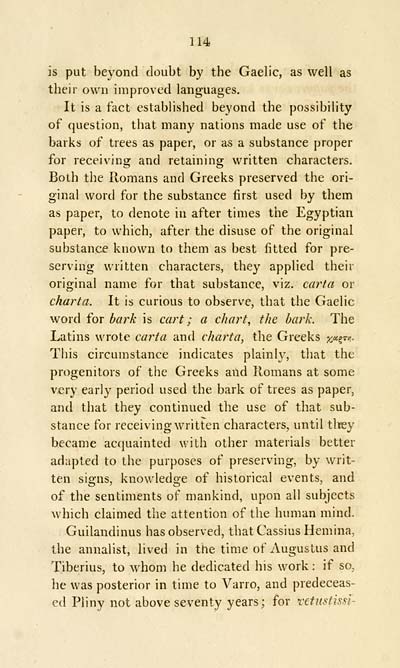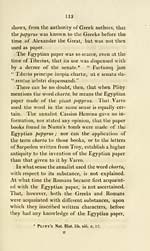Download files
Complete book:
Individual page:
Thumbnail gallery: Grid view | List view

114
is put beyond doubt by the Gaelic, as well as
their own improved languages.
It is a fact established beyond the possibility
of question, tiiat many nations made use of the
barks of trees as paper, or as a substance proper
for receiving and retaining written characters.
Both the Ptomans and Greeks preserved the ori-
ginal word for the substance first used by them
as paper, to denote in after times the Egyptian
paper, to which, after the disuse of the original
substance known to them as best fitted for pre-
serving written characters, they applied their
original name for that substance, viz. carta or
charta. It is curious to observe, that the Gaelic
word ^ox bark is cart; a chart, the bark. The
Latins wrote carta and charta, the Greeks xae^r^..
This circumstance indicates plainly, that the
progenitors of the Greeks and Romans at some
very early period used the bark of trees as paper,
and that they continued the use of that sub-
stance for receiving written characters, until tliey
became acquainted with other materials better
adapted to the purposes of preserving, by writ-
ten signs, knowledge of historical events, and
of the sentiments of mankind, upon all subjects
which claimed the attention of the human mind.
Guilandinus has observed, that Cassius Hemina,
the annalist, lived in the time of Augustus and
Tiberius, to whom he dedicated his work : if so,
he was posterior in time to Varro, and predeceas-
ed Pliny not above seventy years; for retustissi-
is put beyond doubt by the Gaelic, as well as
their own improved languages.
It is a fact established beyond the possibility
of question, tiiat many nations made use of the
barks of trees as paper, or as a substance proper
for receiving and retaining written characters.
Both the Ptomans and Greeks preserved the ori-
ginal word for the substance first used by them
as paper, to denote in after times the Egyptian
paper, to which, after the disuse of the original
substance known to them as best fitted for pre-
serving written characters, they applied their
original name for that substance, viz. carta or
charta. It is curious to observe, that the Gaelic
word ^ox bark is cart; a chart, the bark. The
Latins wrote carta and charta, the Greeks xae^r^..
This circumstance indicates plainly, that the
progenitors of the Greeks and Romans at some
very early period used the bark of trees as paper,
and that they continued the use of that sub-
stance for receiving written characters, until tliey
became acquainted with other materials better
adapted to the purposes of preserving, by writ-
ten signs, knowledge of historical events, and
of the sentiments of mankind, upon all subjects
which claimed the attention of the human mind.
Guilandinus has observed, that Cassius Hemina,
the annalist, lived in the time of Augustus and
Tiberius, to whom he dedicated his work : if so,
he was posterior in time to Varro, and predeceas-
ed Pliny not above seventy years; for retustissi-
Set display mode to: Large image | Transcription
Images and transcriptions on this page, including medium image downloads, may be used under the Creative Commons Attribution 4.0 International Licence unless otherwise stated. ![]()
| Early Gaelic Book Collections > Ossian Collection > Thoughts on the origin and descent of the Gael > (126) |
|---|
| Permanent URL | https://digital.nls.uk/82235956 |
|---|
| Description | Selected books from the Ossian Collection of 327 volumes, originally assembled by J. Norman Methven of Perth. Different editions and translations of James MacPherson's epic poem 'Ossian', some with a map of the 'Kingdom of Connor'. Also secondary material relating to Ossianic poetry and the Ossian controversy. |
|---|
| Description | Selected items from five 'Special and Named Printed Collections'. Includes books in Gaelic and other Celtic languages, works about the Gaels, their languages, literature, culture and history. |
|---|

